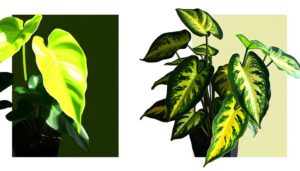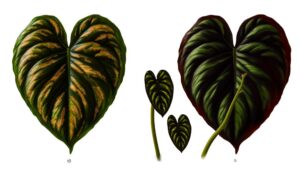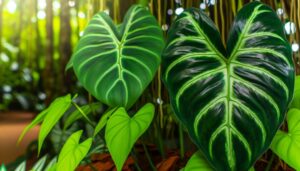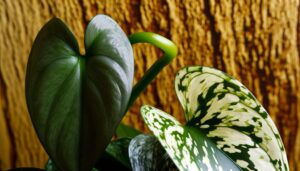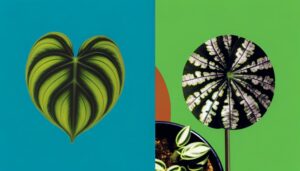Philodendron Rio Vs Brasil: A Comparative Guide!
Philodendron Rio and Philodendron Brasil are cultivars of Philodendron hederaceum, native to Central and South America. Philodendron Rio exhibits silvery-gray striped leaves and a compact growth habit with dense vines.
In contrast, Philodendron Brasil features vibrant yellow to lime-green central stripes and tends to grow longer, more spaced-out vines. Both plants thrive in bright, indirect light and require consistently moist, well-draining soil.
While Rio tolerates lower light better, Brasil benefits from more light exposure for vigorous growth. They share similar care needs but differ in leaf variegation and growth patterns, which are key for distinguishing between them.
To gain further insights on their distinct characteristics, continue exploring their respective attributes.
Comparison of Philodendron Rio and Philodendron Brasil
| Feature | Philodendron Rio | Philodendron Brasil |
|---|---|---|
| Common Name | Philodendron Rio | Philodendron Brasil |
| Botanical Name | Philodendron hederaceum ‘Rio’ | Philodendron hederaceum ‘Brasil’ |
| Leaf Appearance | Green leaves with creamy white variegation | Green leaves with yellow variegation |
| Variegation Pattern | Central silver/white stripe | Central yellow stripe and patches |
| Growth Habit | Climbing or trailing vine | Climbing or trailing vine |
| Light Requirements | Bright, indirect light | Bright, indirect light |
| Watering Needs | Moderate, allow the top inch to dry out | Moderate, allow the top inch to dry out |
| Humidity Preference | Medium to high humidity | Medium to high humidity |
| Temperature Tolerance | 65-80°F (18-27°C) | 65-80°F (18-27°C) |
| Soil Type | Well-draining, aroid mix | Well-draining, aroid mix |
| Fertilization | Monthly during growing season | Monthly during growing season |
| Propagation Methods | Stem cuttings in water or soil | Stem cuttings in water or soil |
| Pest Susceptibility | Spider mites, mealybugs, aphids | Spider mites, mealybugs, aphids |
| Toxicity | Toxic to pets and humans | Toxic to pets and humans |
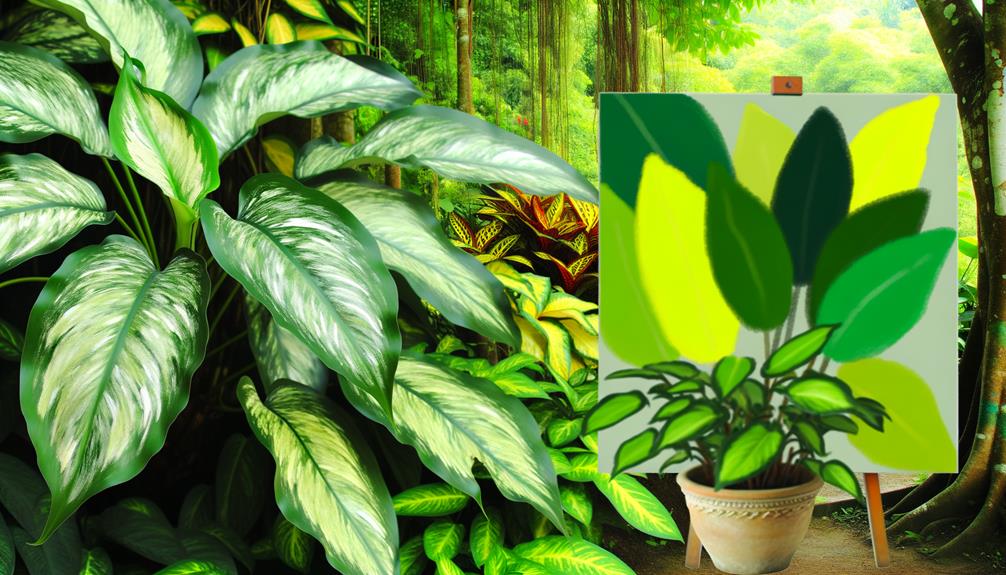
Origins and Background
Both Philodendron Rio and Philodendron Brasil are cultivars of the species Philodendron hederaceum, which is native to the tropical regions of Central and South America. This species thrives in humid, rainforest environments, where it grows as a climbing vine, often utilizing tree trunks for support.
The Philodendron hederaceum species is well-regarded for its adaptability and resilience, which has led to the development of various cultivars. These cultivars have been selectively bred for specific traits, such as unique leaf variegation and growth habits.
The commercial cultivation of Philodendron hederaceum has increased due to its popularity as an ornamental plant, favored for its aesthetic appeal and relatively low maintenance requirements. Consequently, both Rio and Brasil have become highly sought after in the horticultural market.
Leaf Appearance
The leaf appearance of Philodendron Rio and Philodendron Brasil exhibits distinct variegation patterns and colorations, which serve as primary identifiers for these cultivars.
Philodendron Rio features leaves with a central stripe of silvery-gray, flanked by a darker green margin, creating a striking contrast. In contrast, Philodendron Brasil’s leaves display a more vivid variegation, characterized by a bright yellow to lime-green central stripe, surrounded by dark green edges.
The variegation in Rio tends to be subtler and more uniform, while Brasil’s variegation can vary widely between leaves, adding to its visual appeal.
Both cultivars possess heart-shaped leaves, but the coloration differences are key to distinguishing between them, contributing to their unique horticultural value.
Growth Patterns
Examining the growth patterns of Philodendron Rio and Philodendron Brasil reveals distinct characteristics in their vine development and leaf arrangement.
Philodendron Rio tends to exhibit a more compact and bushier growth habit. Its vines are shorter and denser, resulting in a fuller appearance. The leaves of Rio are closely spaced, which contributes to its lush look.
Conversely, Philodendron Brasil displays a more trailing and vining growth pattern. Its vines are longer and more spaced out, making it ideal for hanging baskets or climbing supports. The leaf arrangement in Brasil is more spaced, allowing each leaf to catch more light, hence promoting its vigorous growth.
These differences are essential for understanding their suitability in varying environmental conditions.
Light Requirements
Philodendron Rio and Philodendron Brasil exhibit distinct light requirements, with both thriving in bright, indirect light.
However, Philodendron Rio demonstrates a slightly higher tolerance for low light conditions compared to Philodendron Brasil, which may result in reduced variegation.
Understanding these variations in light tolerance is essential for optimizing growth and maintaining the aesthetic appeal of each cultivar.
Ideal Light Conditions
Both Philodendron Rio and Brasil thrive in bright, indirect sunlight to guarantee maximum growth and vibrant foliage. This lighting condition mimics their natural habitat under the forest canopy, where they receive filtered sunlight.
For peak growth, consider the following:
- Light Source: Position the plants near east or north-facing windows, where they can receive several hours of diffused light.
- Light Intensity: Ensure that the light is not direct, as this can cause leaf burn. Use sheer curtains if necessary to soften the light intensity.
- Light Duration: Aim for approximately 8-10 hours of light per day to support photosynthesis and healthy development.
These conditions will help maintain the plant’s vibrant variegation and overall health.
Tolerance to Low Light
Adapting to low light conditions, both Philodendron Rio and Brasil display remarkable resilience, although their growth and variegation may diminish in reduced lighting environments.
Philodendron Rio, known for its striking silver and green foliage, can tolerate low light but may lose some of its vibrant coloration.
Similarly, Philodendron Brasil, with its characteristic lime green and yellow variegation, can survive in low light but may exhibit less pronounced variegation.
Both plants will experience slower growth rates under insufficient lighting.
To optimize their aesthetic appeal and growth, it is advisable to provide indirect, bright light. This guarantees that both Philodendron Rio and Brasil maintain their distinctive variegation and overall health, even though they are capable of enduring lower light conditions.
Watering Needs
Philodendron Rio and Brasil exhibit similar watering needs, requiring consistent soil moisture without becoming waterlogged. It is essential to maintain appropriate drainage to prevent root rot, making well-aerated soil mixtures vital.
Both varieties thrive with moderate watering schedules, ensuring the top inch of soil is dry before the next watering.
Frequency of Watering
Typically, the watering needs of Philodendron Rio and Brasil should be met by maintaining consistently moist soil while avoiding waterlogging, which can lead to root rot.
The frequency of watering depends on several factors including ambient temperature, humidity, and light levels. Generally, these plants require watering every 7-10 days. However, it is essential to tailor the watering schedule based on specific environmental conditions.
To achieve the best watering, consider the following guidelines:
- Temperature: Higher temperatures may require more frequent watering.
- Humidity: Low humidity environments can cause soil to dry out faster, necessitating increased watering.
- Light Levels: Bright, indirect light can increase water evaporation rates, impacting watering frequency.
Soil Moisture Levels
Maintaining the suitable soil moisture levels for Philodendron Rio and Brasil is essential for their best growth and overall health. Both species thrive in consistently moist, yet not waterlogged, soil. Best soil moisture should be achieved by ensuring the top inch of the soil remains slightly moist to touch, avoiding complete dryness or excessive wetness.
Overwatering can lead to root rot, while underwatering can cause wilting and leaf drop. Utilizing a moisture meter can provide precise readings, ensuring the soil’s moisture content remains within the ideal range.
Regular monitoring and adjusting of watering practices based on the plant’s environment—such as light conditions and ambient humidity—will promote robust growth and prevent common issues related to improper watering.
Drainage Requirements
To guarantee peak health and growth, it is crucial to provide well-draining soil that prevents water accumulation around the roots. Both Philodendron Rio and Brasil thrive in conditions where excess water can readily escape, avoiding root rot.
Optimal drainage can be achieved through:
- Soil Composition: Use a well-aerated mix containing perlite, peat, and pine bark to enhance drainage.
- Container Choice: Select pots with ample drainage holes to facilitate water outflow.
- Watering Practices: Water the plants thoroughly but allow the top inch of soil to dry out between waterings.
Maintaining these conditions ensures that the root systems of both Rio and Brasil remain healthy, promoting robust growth and vibrant foliage. Such practices are crucial for preventing the detrimental effects of overwatering.
Soil Preferences
Both Philodendron Rio and Philodendron Brasil thrive in well-draining, nutrient-rich soil that retains moisture without becoming waterlogged. This balance is crucial to prevent root rot, which can be harmful to both species.
A mix containing peat, perlite, and pine bark is recommended, as it provides the necessary aeration and drainage. The peat component helps retain moisture, while perlite and pine bark guarantee sufficient drainage and prevent compaction.
Soil pH should ideally be slightly acidic to neutral, ranging between 5.5 and 7.0. Regularly replenishing organic matter in the soil will also support the plants’ nutrient needs. Ensuring proper soil composition is vital for the best growth and health of both Philodendron varieties.
Temperature and Humidity
Peak growth for Philodendron Rio and Philodendron Brasil is achieved in temperatures ranging from 65°F to 80°F, with relative humidity levels between 60% and 80%.
These parameters are crucial for maintaining ideal physiological processes, including photosynthesis and transpiration. Both species are sensitive to temperature and humidity fluctuations, which can impact growth and robustness.
To achieve ideal conditions, consider the following:
- Use a hygrometer to monitor humidity levels, ensuring they remain within the 60%-80% range.
- Install a humidifier in environments where indoor air tends to be dry, particularly during winter months.
- Position plants away from drafts and heat sources that can cause rapid temperature changes and lower humidity.
These measures will help sustain healthy, vibrant growth for both Philodendron varieties.
Common Pests
Philodendron Rio and Brasil are vulnerable to common pests such as spider mites, aphids, and mealybugs, which can affect their overall health and growth.
Recognizing these pests early is essential, and applying preventive measures like routine inspection and upholding proper plant hygiene can greatly diminish infestations.
Efficient treatment methods, including the application of insecticidal soaps and neem oil, are necessary for managing and eliminating these pests.
Identifying Common Pests
Understanding the common pests that afflict Philodendron Rio and Brasil is vital for effective plant care and maintenance. These two popular varieties of Philodendron are susceptible to several pests that can hinder their growth.
- Spider Mites: Small, sap-sucking arachnids that create fine webbing on the undersides of leaves, leading to discoloration and stippling.
- Mealybugs: Soft-bodied insects covered in a white, waxy substance that cluster on leaf nodes and emit honeydew, promoting sooty mold.
- Aphids: Small, pear-shaped insects that feed on new growth by piercing plant tissues, resulting in distorted leaves and stunted growth.
Recognizing these pests early is vital for mitigating damage and ensuring the health of your Philodendron plants.
Pest Prevention Tips
To protect your Philodendron Rio and Brasil from common pests, implementing effective prevention strategies is vital. Regular inspection is essential; examine the leaves and stems for early signs of infestation.
Maintain ideal humidity levels, as overly dry conditions can attract spider mites, while excessive moisture can lead to fungal gnats. Ensure proper air circulation by not overcrowding plants, which helps deter aphids and mealybugs. Utilize well-draining soil to prevent root rot, a condition that can indirectly attract harmful pests.
Additionally, quarantine new plants for at least two weeks to avoid introducing pests to existing collections. Finally, clean foliage periodically with a mild insecticidal soap solution to remove dust and potential pests, thereby maintaining overall plant health.
Effective Treatment Methods
Effective treatment methods for common pests affecting Philodendron Rio and Brasil involve a combination of mechanical, biological, and chemical strategies to guarantee thorough pest eradication and plant health.
Mechanical control includes manual removal of visible pests and pruning of infested plant parts.
Biological control utilizes natural predators, such as ladybugs and predatory mites, to suppress pest populations.
Chemical control involves the application of insecticidal soaps and neem oil to target and eliminate pests.
Adhering to these integrated pest management practices ensures the health and importance of Philodendron Rio and Brasil.
Effective treatment methods include:
- Manual Removal: Regularly inspect and physically eliminate pests.
- Natural Predators: Introduce beneficial insects like ladybugs to manage pest populations.
- Insecticidal Soaps: Apply organic insecticidal soaps or neem oil for persistent infestations.
Propagation Methods
Both Philodendron Rio and Brasil can be propagated through several reliable methods, each with specific steps to guarantee successful plant development.
The most common method is stem cuttings, where a healthy stem with at least two nodes is cut and placed in water or a moist substrate until roots form.
Another effective technique is air layering, which involves wounding a section of the stem, applying rooting hormone, and wrapping it with moist sphagnum moss until roots develop.
Additionally, division can be employed by separating the root ball of a mature plant into smaller sections, ensuring each has adequate roots and shoots.
These methods, when executed properly, promote robust growth and enhance the propagation success rate of both varieties.
Ideal Uses
Understanding the propagation methods for Philodendron Rio and Brasil paves the way to exploring their ideal uses in various settings. These versatile plants are particularly suited for enhancing indoor environments due to their aesthetic appeal and adaptability.
Their ideal uses include:
- Interior Decoration: Their variegated leaves add visual interest to living rooms, offices, and reception areas.
- Air Purification: Philodendrons are known for their ability to improve indoor air quality by removing toxins such as formaldehyde.
- Vertical Gardening: Both varieties can be trained to climb trellises or moss poles, making them excellent for vertical garden designs.
Incorporating these plants into various spaces not only enhances the environment aesthetically but also promotes a healthier indoor atmosphere.
Conclusion
In comparing Philodendron Rio and Philodendron Brasil, the distinctions in origins, leaf morphology, and growth patterns are evident.
Both species thrive under specific light, watering, temperature, and humidity conditions, yet each presents unique challenges and advantages in pest management and propagation.
What makes these plants particularly suited to their respective environments? Understanding these differences informs best care practices and enhances their utility in indoor and outdoor settings, ensuring healthy and aesthetically pleasing growth.

